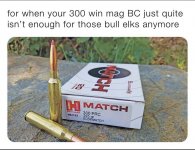unclericco
WKR
Here we go again.
I can see why outfitters want larger cartridges. I have a bunch of big game rifles but I'll never hunt elk with anything smaller than a .284
I can see why outfitters want larger cartridges. I have a bunch of big game rifles but I'll never hunt elk with anything smaller than a .284

